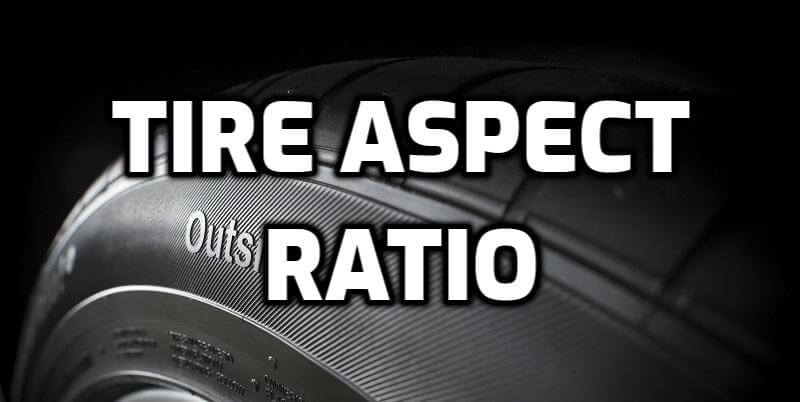Tire Aspect Ratio Explained

When buying new tires for your vehicle, the array of choices and technical jargon can be overwhelming. Among the various factors, the tire aspect ratio is among the most crucial. In this article, we will break down the concept of tire aspect ratio, its importance, and how to choose the correct tire aspect ratio for your vehicle’s needs.
Aspect Ratio Tire Formula
The tire aspect ratio formula is a simple calculation used to determine the percentage representing the tire’s sidewall height relative to its width. The formula for calculating the aspect ratio is:
- Aspect Ratio = (Sidewall Height / Tire Width) x 100
Here, the sidewall height and tire width are measured in millimeters. The resulting aspect ratio is expressed as a percentage. Let’s break down this formula with an example:
Consider a tire with the size notation “225/50R17”. The first number (225) represents the tire width in millimeters, and the second number (50) is the aspect ratio. To find the sidewall height, you can rearrange the formula:
- Sidewall Height = (Aspect Ratio x Tire Width) / 100
In this Case:
- Sidewall Height = (50 x 225) / 100
- Sidewall Height = 112.5 millimeters
So, the sidewall height of this tire is 112.5 millimeters, and the aspect ratio is 50%, meaning the tire’s height is 50% of its width.
What Is The Tire Aspect Ratio?
The aspect ratio is the height of your tire’s sidewall expressed as a percentage of its width. So, if your tire has a width of 205 mm and a sidewall height of 55 mm, its aspect ratio would be 55%. The aspect ratio is important because it affects the tire’s diameter. A tire with a higher aspect ratio will have a taller sidewall and a smaller diameter.
A tire with a lower aspect ratio will have a shorter sidewall and a larger diameter. The aspect ratio also affects the tire’s handling. A taller sidewall will provide more cushioning and make the ride more comfortable. A shorter sidewall will make the tire stiffer and improve its handling.
Can I Change Tire Aspect Ratio?
Yes, you can change your tire’s aspect ratio. The aspect ratio of a tire is the relationship of the tire’s sidewall height to the tire’s width. When you increase the aspect ratio, the sidewall height increases. Consequently, the overall diameter of the tire increases. Conversely, the sidewall height and overall tire diameter decrease if you decrease the aspect ratio.
An increased tire diameter (i.e., a larger aspect ratio) may raise the height of your vehicle slightly and may improve ride comfort as there is more sidewall to absorb bumps. However, it may also lead to a loss in handling precision and increase rolling resistance, which can negatively affect fuel economy.
Decreasing the aspect ratio, which results in a lower profile tire, can enhance your car’s handling because of decreased sidewall flex. However, it can also reduce ride comfort and potentially increase susceptibility to road and rim damage.
It’s also essential to remember that altering your tires from the manufacturer’s recommended size and aspect ratio can affect your speedometer’s accuracy, ABS performance, and other aspects of vehicle performance. It’s always best to consult a tire professional before making these changes.
How To Calculate Tire Aspect Ratio?
To calculate your tire’s aspect ratio, you will need to know the width of your tire and the height of your tire’s sidewall. You can find these dimensions on the sidewall of your tire.
Once you have these dimensions, you can calculate the aspect ratio by dividing the sidewall’s height by the tire’s width. For example, if your tire has a width of 205 mm and a sidewall height of 55 mm, its aspect ratio would be 55%.
Can I Increase The Aspect Ratio On My Tires?
Yes, you can increase the aspect ratio on your tires. However, it is essential to note that increasing the aspect ratio will also decrease the tire’s diameter. If you are looking for a way to raise your car, increasing the aspect ratio may be a good option. Just be aware that it will also increase the tire’s rolling resistance.
Why is Tire Aspect Ratio Important?
The tire aspect ratio directly impacts a vehicle’s handling, ride comfort, and appearance. It significantly determines the tire’s overall performance characteristics, including cornering stability, traction, and fuel efficiency. Here’s a brief overview of how tire aspect ratio influences various aspects of your vehicle:
- Handling: A lower aspect ratio generally offers better cornering and handling due to a shorter, stiffer sidewall. This reduces the tire to flex and allows for more precise steering input. However, it may also result in a harsher ride as the tire has less cushioning to absorb road imperfections.
- Ride Comfort: A higher aspect ratio typically provides a more comfortable ride due to the taller sidewall, which can better absorb bumps and road irregularities. This makes high aspect ratio tires popular for luxury vehicles and long-distance cruisers.
- Appearance: A tire’s aspect ratio also affects the overall appearance of your vehicle. Lower aspect ratios often give a sporty, aggressive look, while higher aspect ratios provide a more classic or conservative appearance.


There appears to be an error in this explanation.
It says increasing the aspect ratio reduces the diameter of the tire when, in actuality, it increases the diameter of the tire
I apologize for the confusion and thank you for pointing that out. It’s updated and fixed.
So if my vehicle tires are 225/55R18 and I use 225/60R18 is it actually a noticeable difference? TY
The overall difference between those tire size is around 3.1% which is exceed the Replacement tires 3% rules. So its not recommended. Given the larger diameter and circumference of the 225/60r18 tire, it may negatively impact fuel efficiency.
Can a 265 50 R20 Spare tire be interchanged on vehicles with same size tires?
Thx
Yes, a 265/50 R20 spare tire can generally be interchanged with vehicles that have the same size tires.
I bought 4 new Radar Dimax tires for my Kia Soulat from a well known tire shop. They put on 3 tires AS-8 205/60 R16-92V. As they did not have a 4th tire in that size, they put on a AS-8 215/55 R16-93V. Will this cause any problems in driving my car?
Mixing tire sizes, especially with different widths and aspect ratios, can affect handling and stability. For optimal safety and performance, it’s advisable to use the same size and type of tire on all four wheels.
How much of a difference in handling and comfort will be seen if I am using 215/50R17 tires instead of 215/60R17 tires. And do you have any idea if switching the tire diameter from factory specs due to different rims would affect the car a lot or a little.
Switching from 215/60R17 to 215/50R17 will result in a firmer ride with potentially sharper handling. Changing tire diameter can affect speedometer accuracy and handling dynamics.
I just acquired a 12-year-old 4×8′ flatbed trailer that currently has a set of 5.70×8 tires and wheels. They are so small that I fear that those little things are spinning so fast that they will blow up at highway speeds!
I want to change these out for a set of 5.3×12 tires and wheels. They will fit just fine and the load rating is the same- C. Do you see any problem with doing this?
Thanks!
Switching to 5.3×12 tires and wheels should improve highway stability. Ensure the load rating and fit are compatible for safe usage.
If I install one 245/70/16 on my P/U with the others being 245/75/16 is there going to be a notable difference or any adverse effects?
Mixing tire sizes like 245/70/16 and 245/75/16 is not recommended. It can cause issues with 4×4 systems and ride quality.
Can l change from 225 x 65 x 17, to 225 x 70 x 17 on my Nissan Pathfinder, after doing the calculation it is increasing the tyre diameter by 13mm.
Yes, you can change your 225/65R17 tires to 225/70R17 tires. Just ensure the load capacity matches or exceeds your vehicle’s requirements.
My Tacoma has 2 tire sizes suggested: 245/70/R16 and 265/70/R16. What is the advantage of either tire? Thanks
The 245/70/R16 tires offer better fuel efficiency, while 265/70/R16 tires improve traction and stability. Consider your driving conditions and priorities to decide.
My motorcycle specifies 120/60-ZR17 for the front and 160/60-ZR17 for the rear. A tire shop is trying to put a 120/70 R17 on the front with the correct 160/60 R17 on the rear (because that’s all they “can get.” Should I allow them to do this?
Switching to a 120/70R17 tire on the front instead of the specified 120/60R17 could affect the motorcycle’s handling, turning characteristics, and potentially the fit within the wheel well. Not recommended
Would like to change tire size on my 2018 Challenger from 245/45/20 to 235/50/20. there is about 0.6 of an inch difference in dia. These will be on the front of the car. The ride should improve a little bit.
Yes, switching from 245/45/20 to 235/50/20 tires increases diameter by about 0.6 inches, potentially improving ride comfort on your 2018 Challenger’s front.
Hello! I’m thinking of changing my Proton Saga 2023 (Sedan) tyres from 185/55/15 to 185/60 or 65/15, yes I love the firmer and sharper handling and cornering of the 55s but I need a bit of cushion for these humps and potholes. Is it advisable to change to higher ratios? What do you think? Thanks
Switching from 185/55/15 to 185/60 or 65/15 can indeed offer more cushion against potholes and bumps, enhancing ride comfort. However, it might slightly alter handling and vehicle dynamics.
What effect will using 265R75 instead of 265R70,. Also what is the difference between a BF Goodrich All Terrain and Trail Terrain?
Using 265R75 instead of 265R70 will increase overall tire diameter, raising ground clearance but potentially affecting speedometer accuracy and fuel economy. BF Goodrich All Terrain tires are more aggressive for severe off-road use, while Trail Terrain tires offer better on-road comfort with light off-road capability.